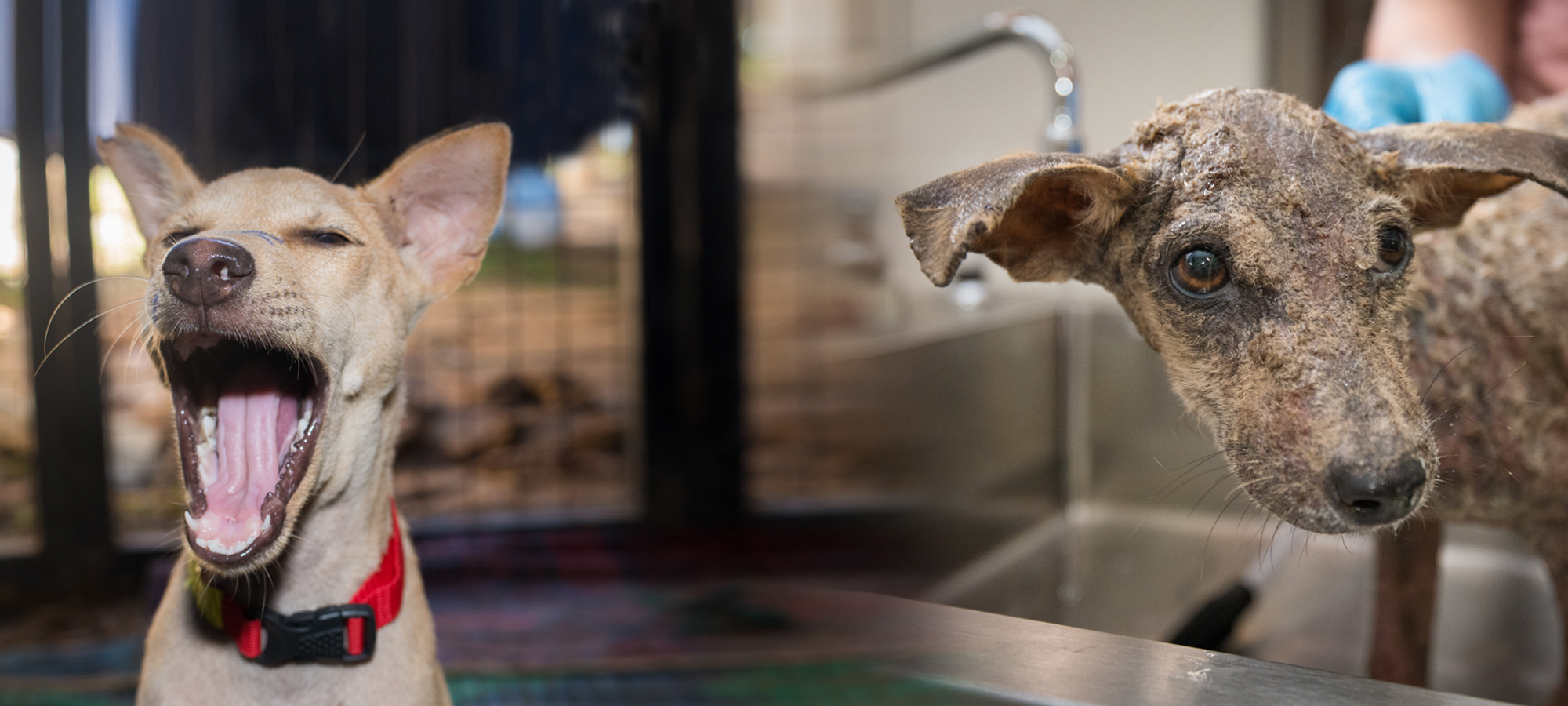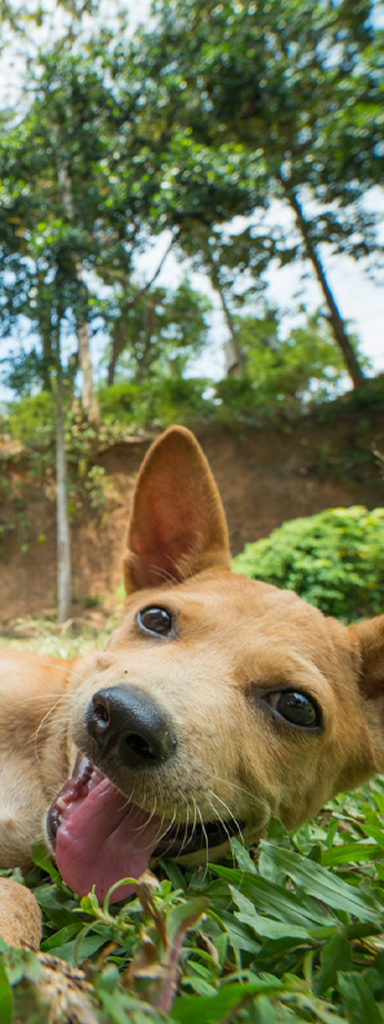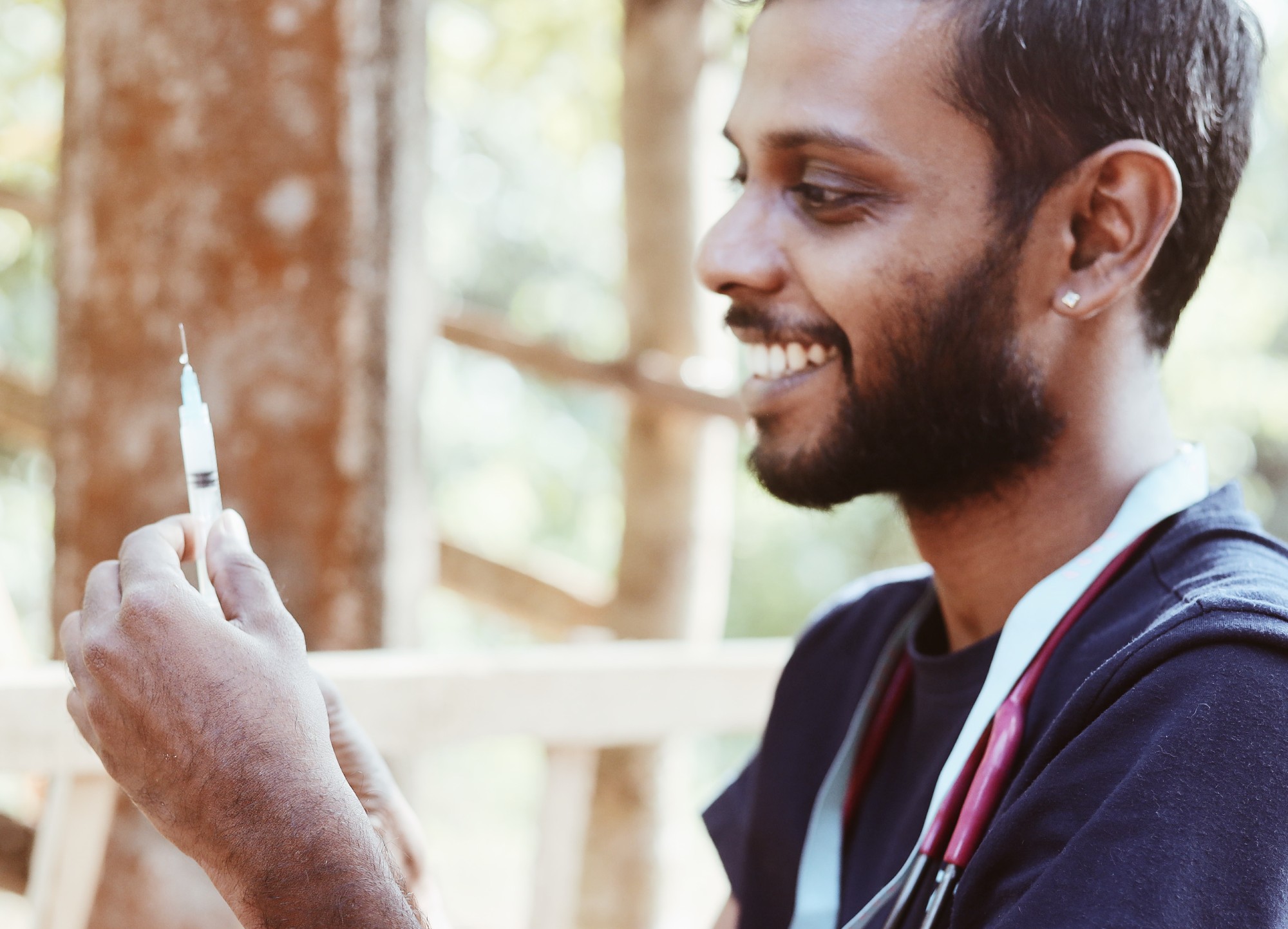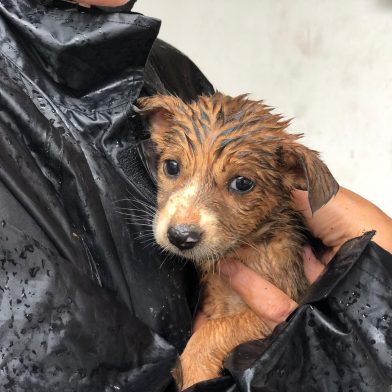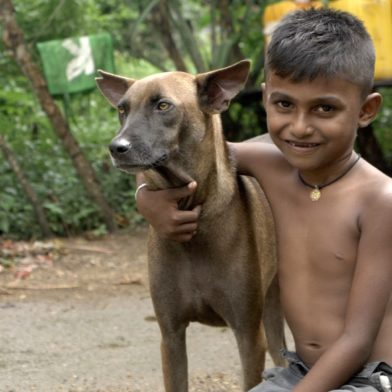
Vaccination is a huge part of what we do at WECare, to keep the street and owned dog population in Sri Lanka safe and healthy.
The DHLP vaccine is administered annually, protecting against distemper, hepatitis, leptovirus and parvovirus, as well as a yearly rabies jab, which is perhaps the most important of all, as it helps protect the human community too.
Rabies is a vaccine-preventable, zoonotic (one that transfers from animals to humans) viral disease that’s almost 100% fatal in humans once symptoms show.
According to the World Health Organisation (WHO), rabies is estimated to cause 150,000 human deaths annually – 99% of these as a result of dog bites.
Sadly, children are disproportionately affected.
What are the signs of rabies?
There are two types of rabies – furious and paralytic (or dumb).
In dogs, furious rabies causes extreme behavioural changes, agression, hyperactivity, and an insatiable appetite, with the animal attempting to consume non-food items, like stones or mud. The dog will usually die of a seizure within a few days.
Paralytic/dumb rabies is the most common form in dogs, with symptoms ranging from hypersalivation (foaming at the mouth), difficulty swallowing, facial distortion, weakness, and paralysis. The dog will slip into a coma within days, and die.
The virus spreads via an infected animals’ saliva (NOT via blood, urine or faeces), into broken skin (via bites or scratches) or mucous membranes (eyes, mouth, nose), travelling through the central nervous system and eventually reaching the brain.
Clinical signs won’t show until the virus has reached the spinal cord or brain – this incubation period in humans can range from a few days to a year in some cases, depending on the type of rabies, viral load, how far the exposure site is from the spinal cord/brain, and if the victim is vaccinated.
According to the WHO, initial symptoms of rabies in humans include a fever with pain, and a tingling, prickling or burning sensation around the wound.
While paralytic rabies is more common in dogs, it only accounts for around 20% of reported human cases, as a) it’s often misdiagnosed and b) you’re more likely to be bitten by a dog with furious rabies, due to their increased aggression.
Signs of furious rabies in humans include hyperactive or excitable behaviour, hydrophobia (a fear of water), and aerophobia (fear of drafts/fresh air) in some cases. The patient will usually die from cardiac arrest a few days after showing clinical signs.
Paralytic rabies is usually a much slower process – the victim’s muscles will slowly become paralysed, starting at the site of the wound, and they’ll eventually slip into a coma, before dying. This can take up to a month.
While this all sounds incredibly scary, the positive news is that rabies is 100% preventable when treated properly with post-exposure prophylaxis (PEP).
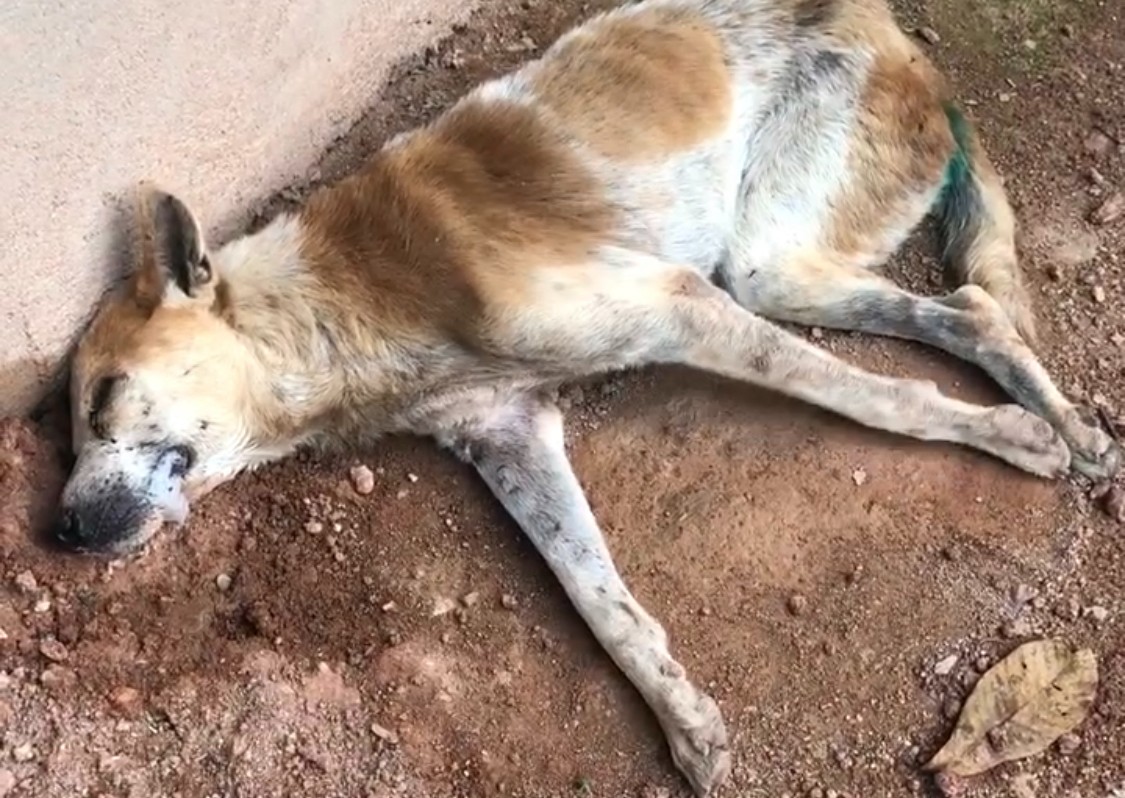
Is there rabies in Sri Lanka?
Rabies isn’t something that concerns most people in the western world – the virus was eradicated from all animals (except bats) in the UK in 1922. The first UK rabies death in 100 years was reported in 2002, when a bat conservationist died after refusing vaccination following a bat bite.
Sadly, in Sri Lanka, it’s a very different story – the virus is endemic here, with an estimated 20-30 rabies deaths in humans annually, according to Public Health Veterinary Services. Tragically, in the first half of this year alone, 12 people died due to rabies. Just last month, a two-year-old died after being bitten by a rabid dog.
The main causes of rabies deaths are unvaccinated dogs, and victims not realising they should seek post-exposure treatment. Puppies carry the highest risk of infection – you can imagine how easy it is for a playful, sharp-toothed pup to break someone’s skin. While manufacturers usually recommend the first rabies vaccine is administered in dogs at 12 weeks old, studies have shown it’s actually best to vaccinate ASAP in endemic countries. This is why we vaccinate puppies as soon as their eyes are open (or as soon as we get our hands on them!).
In May of this year, at the height of the economic crisis, it was reported that there was a shortage of the human rabies vaccine, due to a lack of funds to procure them. Alarmingly, Chairman of the Society of Government Pharmacists, Ajith P. Thilakaratne advised that a number of lives would be lost due to said shortage.
At the end of July, India donated 25,000 rabies vaccines to Sri Lanka, which helped out massively. Now, the booster vaccine is more widely available, but there’s still a serious shortage of immunogloblin, which is needed for severe bites and for those who haven’t received a pre-exposure jab (more on that below).
It’s been an anxious time for those of us in the dog rescue world – regrettably, we’ve had to cancel previously planned outreach programmes, as we couldn’t guarantee there would be appropriate post-exposure treatment if a volunteer or member of staff got bitten.
Donate to our current rabies vaccination project
What should you do if bitten by a dog in Sri Lanka?
Firstly, don’t panic. Even if the dog does have rabies, so long as you receive PEP ASAP, you will be fine. (Just ask our founder, Janey – she’s been bitten by multiple rabid dogs and is still here to tell the tale…!).
Wash the wound immediately and thoroughly for a minimum of 15 minutes, with soap and water, detergent or povidone-iodine.
If the dog is an owned dog, ask to see its vaccination status. Even if they can show a record of rabies vaccination within the last year, you should still go to the hospital. Where possible, monitor the animal in the days and weeks following the bite – has its behaviour changed? Has it fallen ill? Did it die suddenly?
Now it’s time to find a vaccine ASAP – ideally within 72 hours, but go as soon as you can, even if you think the dog is free of rabies. Every person’s incubation period is different – you could have a few days or a few months – and you can receive the vaccine any time up until symptoms develop, so just keep trying until you find a hospital with appropriate PEP. It’s always better to be safe than sorry.
If you received a rabies pre-exposure vaccine in the last year, take your vaccine card to the hospital with you. (You’ll be treated as unvaccinated if you can’t show proof of vaccination.) With the current immunigloblin shortage, it’s best to call ahead and ask local hospitals (government or private) if they have stock – if you don’t speak Sinhala (or Tamil, if you’re in a Tamil area), it may be better to ask a local to call for you.
Those with up-to-date pre-exposure will be given a course of treatment dependent on the severity of the wound – minor bites will receive a course of post-exposure booster vaccines, while major bites will also be given a rabies immunogloblin (RIG) injection. Vaccine-induced antibodies can take a week to appear, so RIG protects you by neutralising potential virus in the wound during this interval.
If you haven’t had a pre-exposure jab (or can’t produce a valid vaccine card), you’ll also receive RIG as well as the post-exposure booster.
It’s important to note that unless you’re working with dogs or incessantly hounding street pups, the chances of being bitten here in Sri Lanka are small. However, with the current immunogloblin shortage, we strongly advise all tourists visiting Sri Lanka to get a pre-exposure vaccine ahead of their trip, to make things easier should you need to find treatment. Having to fly home because you got bitten but can’t find immunogloblin? Not the best way to end a holiday.

How is WECare helping?
The WHO states that mass canine vaccination is the most effective measure in controlling the rabies virus. Thankfully, there’s no shortage of the canine rabies vaccine in Sri Lanka.
Neutering and vaccination is a huge part of what WECare does, and we vaccinate every animal that we treat, administering around 2,500 rabies shots in the last year. You might be wondering how neutering helps the fight against rabies? Well, a dog that doesn’t exist can’t be infected – it’s as simple as that. With an estimated one to four million (yup, it’s impossible to do an accurate dog count) roaming dogs on the island, neutering is the best way of curbing population growth, thereby reducing the rabies risk.
We’ve just embarked on a six-month rabies vaccination programme, where we’ll be vaccinating and microchipping (thanks to funding from Battersea and a generous discount from Micro-ID) a whopping 7,000 dogs.
Our neutering and vaccination outreach was heavily impacted by the Covid-19 lockdowns, so we have a lot of work to do to catch up and keep the human and dog community safe – it’s certainly not an easy task, but we’re determined to get it done.
If you’d like to donate towards our vaccination drive, you can do so here.
For more information on rabies, please read our blog post, ‘What is rabies and why do we vaccinate against it?’.
Share this post
Go on, give it a share and spread the word about WECare to all your online pals!
Related reads
